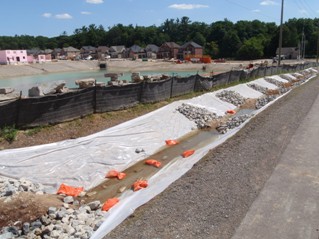Evaluation of an Anionic Polymer for Construction Runoff Treatment – Vaughan, Ontario
This field study evaluated the performance of products containing the polymer anionic polyacrylamide (PAM) for treatment of construction runoff. PAMs are a group of high molecular weight, water soluble molecules formed by polymerization of acrylamide. Anionic PAM is one of the more popular polymers marketed for water clarification and erosion control, and was selected for evaluation based on promising performance and low toxicity findings in studies completed to date.
The main objectives of the study were to quantify the polymer’s performance, determine which application method would be most effective, and identify the key factors that affected performance. Results will assist in the establishment of policies and guidelines governing the use of polymers, and help to inform future education and training on polymer applications for construction sites.
Field monitoring was carried out in 2009 on a 77 ha construction site in Vaughan. Two applications of anionic PAM products were used to treat water being pumped out of the onsite construction sediment control pond. In the first application, the product was used in a roadside ditch, and in the second application it was introduced via a mixing tank installed in series with a larger settling tank. For each application a polymer-free control was also installed in order to separate the effect of the polymer from that of the ditch or tank alone. Samples collected from both applications were submitted for analysis of turbidity, suspended solids concentrations, and particle size distributions.
Results showed that despite a wide variation in performance from one experiment to the next, the systems in which polymer products were used were consistently more effective at reducing suspended solids than the corresponding control systems for both applications. Neither the ditch nor the tank was demonstrated to perform more effectively than the other with respect to reducing suspended solids levels, but rather performance of the polymer systems was found to be dependent upon the extent to which the experiment allowed for proper dosing (dissolution of the polymer into the water), mixing, and final filtration.
The final report, available under ‘downloads’ on the right, also includes a literature review that summarizes research on the nature, performance, and safety of PAM and some of its polymer alternatives.

